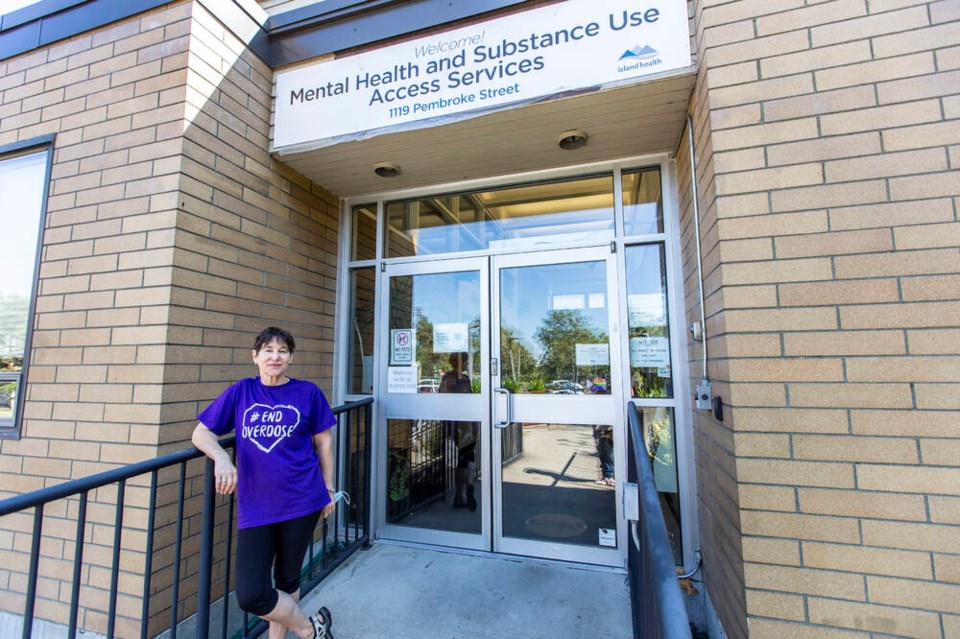A Victoria addictions specialist says the province risks “throwing the baby out with the bath water” with its shift from a take-home model to a witnessed one for patients who are prescribed opioids to treat addiction.
Dr. Caroline Ferris argues responsible practitioners can distinguish between patients in withdrawal from street drugs who benefit from safer alternatives like hydromorphone and those wanting to sell them.
“We’re quite upset as an addiction medicine community at the prospect of having a very useful tool removed from our toolbox,” Ferris said Thursday, the day after Health Minister Josie Osborne announced the change.
It comes on the heels of a Health Ministry briefing for police leaked this month that said a “significant portion” of opioids prescribed in B.C. are ending up being trafficked provincially, nationally and internationally.
In a witnessed-only program, patients would consume prescribed hydromorphone pills, also called Dilaudid or Dillies, in front of a pharmacist or health-care worker so the drugs don’t end up being sold on the street.
“We can’t deny the bags full of pills that the cops have confiscated and we see people coming in saying, ‘I think I’m hooked on the Dillies I buy from a friend’ — that’s not news whatsoever,” said Ferris, former Island Health medical lead for mental health and substance use.
“We’ve always tried to strike a balance between being able to help our patients, individual patients, and having responsibility for public safety.”
Ferris said hydromorphone is used very successfully as a take-home prescription to manage withdrawal as a person moves from street-purchased fentanyl to a maintenance program, including methadone or suboxone, or into treatment and recovery. The dosage isn’t a one-size-fits-all for patients, however.
“Using short-term hydromorphone prescribing is a really useful adjunct when we’re getting people started on their longer-acting medications like methadone, and we really don’t think the government should be dictating how we should do that,” said Ferris.
“For somebody who’s a new patient, we don’t really know what their tolerance is — we can’t have them swallow 14 pills all at once at the pharmacy — they can overdose on that.”
Ferris said regular urine drug screening shows whether a patient is taking their prescribed hydromorphone, and there are also clear signs for physicians that a patient is benefiting from safer supply. They may appear healthier, they may gain weight or secure housing or reconnect with family.
People who are working and have dependents to care for or live in rural and remote communities will find it hard to get to a pharmacy once a week, “let alone daily, or multiple times a day,” to be witnessed taking their drugs, she said.
“To cut them off is brutal,” said Ferris. “It would probably destabilize them because they will go into withdrawal and then they’ll have to go look for more street drugs.”
Former B.C. coroner Lisa Lapointe, who stepped down in February after the NDP government’s refusal to expand safer supply, called the government’s shift to a witnessed model for safer supply “shocking.”
Lapointe said the government needs to release the evidence on which it has based this “significant change,” which she said was made without consulting the medical community, addictions medicine specialists, the provincial health officer or medical health officers.
“All we have is a leaked memo, and now this dramatic change in a program that has been very effective for those limited number of people who can access it,” said Lapointe.
Lapointe said people with access to a regulated supply of opioids do very well, and most importantly, “they do not die.”
“It’s just so promising, so to curtail that program in this really dramatic way, I’m really concerned that people will die,” she said, adding people will undoubtedly “fall off the program” if required to go into a pharmacy daily or multiple times a day.
Victoria Police Chief Del Manak, however, applauded the government’s introduction of additional “safeguards” for the safer supply program, during a city council meeting on Thursday.
Manak said when Victoria officers are out executing search warrants, they have regularly found people in possession of prescriptions for other people.
“So people who do trade their prescription drugs in for illicit street drugs, that is something that has been happening in every community across this province,” said Manak.
While the police force supports harm-reduction measures, policies are needed “that look after the overall health of our community,” which means more focus on prevention, treatment and recovery, he said.
“I think sometimes we focus too much and, in a way unintended, but we foster dependency through easy access where we should be doing everything we can to help people along the continuum and have more options for them.”
— With files from Andrew Duffy



